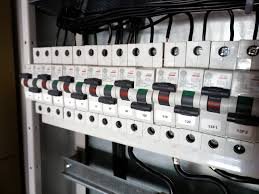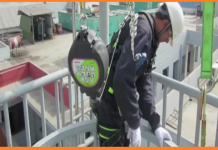Contents
MCB (Miniature Circuit Breaker) is old.
- Rated current, not more than 100 A.
- Trip characteristics normally not adjustable.
- Thermal or thermal-magnetic operation.
MCCB (Molded Case Circuit Breaker).
- Rated current up to 1000 A.
- Trip current may be adjustable.
- Thermal or thermal-magnetic operation.
CLICK HERE FOR ? ELECTRICAL SAFETY
Air Circuit Breaker
- Rated current up to 10,000 A.
- Trip characteristics often fully adjustable including configurable trip thresholds and delays.
- Usually electronically controlled—some models are microprocessor controlled.
- Often used for main power distribution in a large industrial plants, where the breakers are arranged in draw-out enclosures for ease of maintenance.
Vacuum Circuit Breaker
- With rated current up to 3000 A,
- These breakers interrupt the arc in a vacuum bottle.
- These can also be applied at up to 35,000 V. Vacuum breakers tend to have longer life expediencies between overhaul than do air circuit breakers.
CLICK HERE FOR ? PPE IS CODE
RCD (Residual Current Device) / RCCB( Residual Current Circuit Breaker)
- Phase (line) and Neutral both wires connected through RCD.
- It trips the circuit when there is earth fault current.
- The amount of current flows through the phase (line) should return through neutral.
- It detects by RCD. any mismatch between two currents flowing through a phase and neutral detect by RCD and trip the circuit within 30Miliseconed.
- If a house has an earth system connected to an earth rod and not the main incoming cable, then it must have all circuits protected by an RCD (because u might not be able to get enough fault current to trip an MCB)
- The most widely used is 30 mA (milliamp) and 100 mA devices. A current flow of 30 mA (or 0.03 amps) is sufficiently small that it makes it very difficult to receive a dangerous shock. Even 100 mA is a relatively small figure when compared to the current that may flow in an earth fault without such protection (hundred of amps)
- A 300/500 mA RCCB may be used where only fire protection is required. eg., on lighting circuits, where the risk of electric shock is small
- RCDs are an extremely effective form of shock protection.
CLICK HERE FOR ? SCAFFOLDING
Limitation of RCCB
- RCD will not protect against the overheating that results when conductors are not properly screwed into their terminals.
- RCD will not protect against live-neutral shocks, because the current in the live and neutral is balanced. So if you touch live and neutral conductors at the same time (e.g., both terminals of a light fitting), you may still get a nasty shock.
- Standard electromechanical RCCBs are designed to operate on normal supply waveforms and cannot be guaranteed to operate where none standard waveforms are generated by loads. The most common is the half-wave rectified waveform sometimes called pulsating dc generated by speed control devices, semiconductors, computers, and even dimmers.
- Specially modified RCCBs are available which will operate on normal ac and pulsating dc.
- RCDs don’t offer protection against current overloads: RCDs detect an imbalance in the live and neutral currents. A current overload, however large, cannot be detected. It is a frequent cause of problems with novices to replace an MCB in a fuse box with an RCD. This may be done in an attempt to increase shock protection. If a live-neutral fault occurs (a short circuit, or an overload), the RCD won’t trip and may be damaged. In practice, the main MCB for the premises will probably trip, or the service fuse, so the situation is unlikely to lead to catastrophe; but it may be inconvenient.
- It is now possible to get an MCB and RCD in a single unit called an RCBO (see below). Replacing an MCB with an RCBO of the same rating is generally safe.
- Nuisance tripping of RCCB: Sudden changes in electrical load can cause a small, brief current flow to earth, especially in old appliances. RCDs are very sensitive and operate very quickly; they may well trip when the motor of an old freezer switches off. Some equipment is notoriously `leaky’, that is, generate a small, constant current flow to earth. Some types of computer equipment, and large television sets, are widely reported to cause problems.
- RCD will not protect against a socket outlet being wired with its live and neutral terminals the wrong way round.
CLICK HERE FOR ? SOP
ELCB (Earth Leakage Circuit Breaker)
- Phase (line), Neutral and Earth wire connected through ELCB.
- ELCB is working based on Earth leakage current.
- Operating Time of ELCB:
- The safest limit of Current which Human Body can withstand is 30ma sec.
- Suppose Human Body Resistance is 500Ω and Voltage to the ground is 230 Volt.
- The Body current will be 500/230=460mA.
- Hence ELCB must be operated in 30maSec/460mA = 0.65msec.
RCBO (Residual Circuit Breaker with OverLoad)
- It is possible to get a combined MCB and RCCB in one device (Residual Current Breaker with Overload RCBO), the principals are the same, but more styles of disconnection are fitted into one package
CLICK HERE FOR ? HIRA
Difference between ELCB and RCCB.
- ELCB is the old name and often refers to voltage operated devices that are no longer available and it is advised you replace them if you find one.
- RCCB or RCD is the new name that specifies current operated (hence the new name to distinguish from voltage-operated).
- The new RCCB is best because it will detect any earth’s fault. The voltage type only detects earth faults that flow back through the main earth wire so this is why they stopped being used.
- The easy way to tell an old voltage-operated trip is to look for the main earth wire connected through it.
- RCCB will only have the line and neutral connections.
- ELCB is working based on Earth leakage current. But RCCB is not having sensing or connectivity of Earth, because fundamentally Phase current is equal to the neutral current in a single phase. That’s why RCCB can trip when both currents are deferent and it withstands up to both the currents are same. Both the neutral and phase currents are different that means current is flowing through the Earth.
- Finally, both are working for the same, but the thing is connectivity is the difference.
- RCD does not necessarily require an earth connection itself (it monitors only the live and neutral).In addition, it detects current flows to earth even in equipment without the earth of its own.
- This means that an RCD will continue to give shock protection in equipment that has faulty earth. It is these properties that have made the RCD more popular than its rivals. For example, earth-leakage circuit breakers (ELCBs) were widely used about ten years ago. These devices measured the voltage on the earth’s conductor; if this voltage was not zero this indicated a current leakage to earth. The problem is that ELCBs need a sound earth connection, as does the equipment it protects. As a result, the use of ELCBs is no longer recommended.
CLICK HERE FOR ? SAFETY INTERVIEW QUESTIONS
MCB Selection
- The first characteristic is the overload which is intended to prevent the accidental overloading of the cable in a no-fault situation. The speed of the MCB tripping will vary with the degree of the overload. This is usually achieved by the use of a thermal device in the MCB.
- The second characteristic is the magnetic fault protection, which is intended to operate when the fault reaches a predetermined level and to trip the MCB within one-tenth of a second. The level of this magnetic trip gives the MCB its type characteristic as follows: – ·
- Type Tripping Current Operating Time
- Type B 3 To 5-time full load current 0.04 To 13 Sec
- Type C 5 To 10 times full load current 0.04 To 5 Sec
- Type D 10 To 20 times full load current 0.04 To 3 Sec
- The third characteristic is the short circuit protection, which is intended to protect against heavy faults may be in thousands of amps caused by short circuit faults.
- The capability of the MCB to operate under these conditions gives its short circuit rating in Kilo amps (KA). In general, for consumer units, a 6KA fault level is adequate whereas for industrial boards 10KA fault capabilities or above may be required.
Also, read this:
PLEASE SHARE THIS ARTICLE WITH YOUR RELEVANT FRIENDS














Good information
Thank you